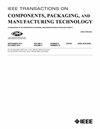Wet Etching Process Optimization and Consistency Enhancement of Massive Through Glass Vias Through Laser-Induced Wet Etching
IF 3
3区 工程技术
Q2 ENGINEERING, ELECTRICAL & ELECTRONIC
IEEE Transactions on Components, Packaging and Manufacturing Technology
Pub Date : 2025-06-11
DOI:10.1109/TCPMT.2025.3578609
引用次数: 0
Abstract
Through glass via (TGV) technology presents a promising alternative for 3-D vertical interconnects in advanced packaging. As device integration progresses, the number of through vias in glass interposers is on the rise, which presents challenges in achieving high-quality and consistent processing of massive TGVs. This study utilizes laser-induced wet etching, complemented by multienergy field mixing assistance to produce highly consistent and significant quantities of TGVs on Corning Eagle XG (EXG) glass. Initially, a specialized wet etching system was developed, featuring an ultrasonic field, temperature control for a water bath, and sample reciprocation. The impact of these parameters on the morphology of the TGVs was systematically investigated. In addition, the study explored the mechanisms by which various etching parameters—such as temperature, etchant concentration, and ultrasonic power—affect the consistency of the TGVs. Ultimately, through the optimization of etching parameters via orthogonal experiments and statistical data sampling, it was confirmed that integrating an ultrasonic field, sample reciprocation, and rotation during the etching process significantly enhances the quality and consistency of the massive TGVs. The consistency of all TGVs (26898 per substrate) was enhanced with a relative standard deviation of 0.73% for the surface hole diameter and an etching rate of湿法蚀刻工艺优化及激光诱导玻璃通孔一致性增强
通过玻璃通孔(TGV)技术提出了一个有前途的替代3d垂直互连在先进的封装。随着器件集成的进展,玻璃中间层中的通孔数量不断增加,这给实现高质量和一致的大规模tgv加工带来了挑战。本研究利用激光诱导湿法蚀刻,辅以多能场混合辅助,在康宁Eagle XG (EXG)玻璃上产生高度一致且数量可观的tgv。最初,开发了一个专门的湿法蚀刻系统,具有超声波场,水浴温度控制和样品往复。系统地研究了这些参数对tgv形貌的影响。此外,研究还探讨了不同蚀刻参数(如温度、蚀刻剂浓度和超声功率)对tgv一致性的影响机制。最终,通过正交实验和统计数据采样对刻蚀参数进行优化,证实了在刻蚀过程中集成超声场、样品往复和旋转可以显著提高大规模tgv的质量和一致性。表面孔直径的相对标准偏差为0.73%,蚀刻速率为$1.24~\mu $ m/min,所有tgv的一致性(每基板26898)都得到了提高。这种用于高一致性大规模tgv的先进蚀刻技术大大提高了在3d封装应用中利用tgv的设备的生产率和实用性。
本文章由计算机程序翻译,如有差异,请以英文原文为准。
求助全文
约1分钟内获得全文
求助全文
来源期刊

IEEE Transactions on Components, Packaging and Manufacturing Technology
ENGINEERING, MANUFACTURING-ENGINEERING, ELECTRICAL & ELECTRONIC
CiteScore
4.70
自引率
13.60%
发文量
203
审稿时长
3 months
期刊介绍:
IEEE Transactions on Components, Packaging, and Manufacturing Technology publishes research and application articles on modeling, design, building blocks, technical infrastructure, and analysis underpinning electronic, photonic and MEMS packaging, in addition to new developments in passive components, electrical contacts and connectors, thermal management, and device reliability; as well as the manufacture of electronics parts and assemblies, with broad coverage of design, factory modeling, assembly methods, quality, product robustness, and design-for-environment.
 求助内容:
求助内容: 应助结果提醒方式:
应助结果提醒方式:


